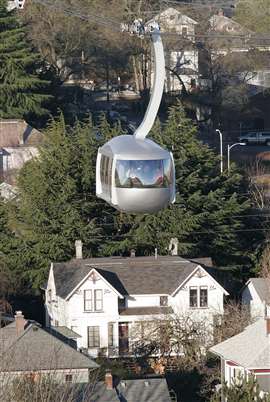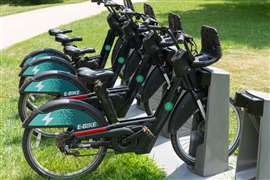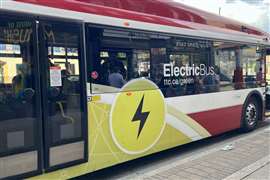Nontraditional transit discussed at CUTRIC conference
12 November 2024
Much of the focus of the sixth-annual Zero Emission Transit & Mobility (ZETM) conference, hosted last month by the Canadian Urban Transit Research & Innovation Consortium (CUTRIC), was on zero emission trends in traditional transit within Canada, such as bus and rail. However, some of the ZETM conference addressed nontraditional transit options.
“It’s not a secret: traffic congestion, high levels of GHG (greenhouse gas) emissions — these are some of the challenges that we’re dealing with in our cities now,” said Desmond Jaricha, social scientist for low carbon smart mobility at CUTRIC. “These are problems that are not going away, and they’re just going to get worse.”
Jaricha said CUTRIC is working with transit agencies to find sustainable, complementary transit solutions that don’t necessarily conform to existing infrastructure and won’t disrupt that infrastructure.
“If someone were to hop off a train, how would they be able to then connect to go home?” he said. “If someone is hopping off a bus and wants to go to the train, how do they do that? So, [we’re] just trying to find those kinds of solutions that can fit in between and also be the primary solution for a person to use from their home to a place where they’re going to go.”
Aerial Gondola Systems
One such alternative approach is the use of aerial gondolas. Jaricha said that such solutions, which many have likely seen at ski resorts, are becoming more popular transit solutions in South America and Europe.
 One of the two cars for the aerial tram in Portland, Ore., passes over a neighborhood January 31, 2007. (Photo: Reuters/Richard Clement)
One of the two cars for the aerial tram in Portland, Ore., passes over a neighborhood January 31, 2007. (Photo: Reuters/Richard Clement)
“If you look at the United States, they’re using them in Portland (Oregon), and it’s successful,” Jaricha said.
According to Portland’s aerial tram website gobytram.com, the city’s solution was designed by AGPS Architecture of Zurich, Switzerland, and Los Angeles, Calif. Opened in January 2007, it travels 3,300 linear feet from the South Waterfront campus of Oregon Health & Science University (OHSU) to the university’s Marquam Hill campus. Each gondola has a capacity of 79 people and travels at 22 mph, rising to a height of 500 ft. The tram carries about 10,000 riders each weekday.
Speaking about typical use cases, Jaricha said, “You’re moving about 6,000 people every hour. And I was in conversation with some colleagues from Leitner-Poma, who design and implement these systems, and they’re saying their technology is getting them to almost 12,000-plus per hour.”
Leitner-Poma of America is a subsidiary of Poma S.A. of Voreppe, France. With headquarters in Grand Junction, Colo., Leitner-Poma offers a variety of cable transport systems. The company’s website said its multicable urban passenger designs can currently carry up to 6,000 passengers per hour per direction, with up to 35 passengers per gondola. The top speed is 8 m/s (approx. 18 mph) over a 1.8-mile distance.
According to the Leitner-Poma website, such aerial systems contribute to decarbonization by being completely electric, with photovoltaic panels atop gondolas and station rooftops to alleviate grid power consumption.
“If you can get people out of cars and into a gondola that can just go over traffic, you can just imagine sitting in there looking down at people stuck in traffic, and you’re just going straight to where you’re trying to get to after work,” Jaricha said.
Other Transit Alternatives
Jaricha said the ZETM conference touched on other alternatives to traditional transit. These include electric bicycles.
 Electric bikes parked at a sharing station in Toronto, Canada. (Photo: eugen via Adobe Stock)
Electric bikes parked at a sharing station in Toronto, Canada. (Photo: eugen via Adobe Stock)
“That is a system that is very efficient in the city,” Jaricha said. “If you’re working downtown and you want to get from a meeting in one place to another meeting somewhere else, instead of having to wait by the bus stop, you can just use your card, get a bike, ride it to a place where you’re trying to get to, and then just leave it there.”
Autonomous shuttles also have potential, although Jaricha said the technology is still in its infancy. For example, the University of Waterloo in Ontario launched an autonomous shuttle in June 2021. There are now three such buses — called WATonoBuses — in operation at the university for research purposes. Additionally, in Whitby, Ontario, the Whitby Autonomous Vehicle Electric (WAVE) shuttle pilot project completed in February 2022.
While not necessarily a zero emission alternative, ridesharing and taxi services do offer opportunities to reduce emissions when used to accommodate several individuals.
“If you’re at home trying to get to work, just go on your phone, order and book a taxi,” Jaricha said. “It comes to your doorstep, and you and four or five other people in your neighborhood jump in, and it gets you to where you need to go.”
Educating Consumers
One of the challenges Canadian transit agencies face is the ongoing preference for many consumers to use their automobiles.
“From our research, what we determined is that people prefer cars because cars are convenient for whatever plans they have,” Jaricha said, adding that not having to abide by like set transit schedule provides individuals with more flexibility.
“That is why we included on-demand transit in our research, because the more transport can come to where you are, pick you up and take you where you want to go, the less you need to have a private vehicle,” Jaricha said.
He added, “We’re trying to find solutions that say you don’t need a car. You can just get out of your house, an autonomous shuttle will come and pick you up, take you to the doctor, drop you by the doctor’s office, and you can go for your appointment.
Mitigating Cost
According to Jaricha, all these solutions must be more cost-effective than operating a private vehicle.
“While you were going to use CA$20 on gas to get to where you are going to, it [on-demand transit] can cost you like CA$5 depending on what the fares are,” he said.
To convince individuals of the value of using alternative transit options, CUTRIC and transit agencies must do more education.
“There is a lot of public dissemination that also needs to happen as we continue to introduce these technologies just so that we can teach people and show people that this is better than what you’ve been doing all along,” Jaricha said.
CONECTAR-SE COM A EQUIPE






